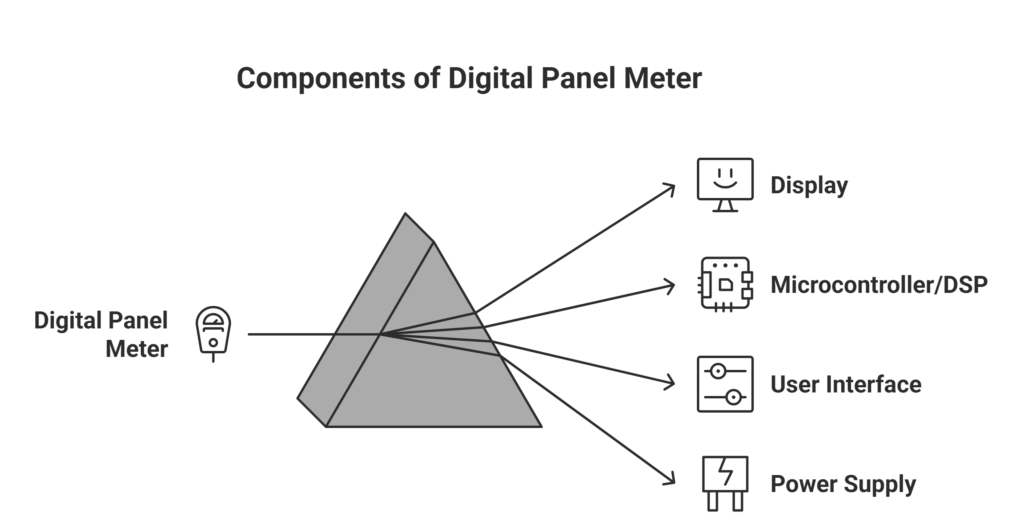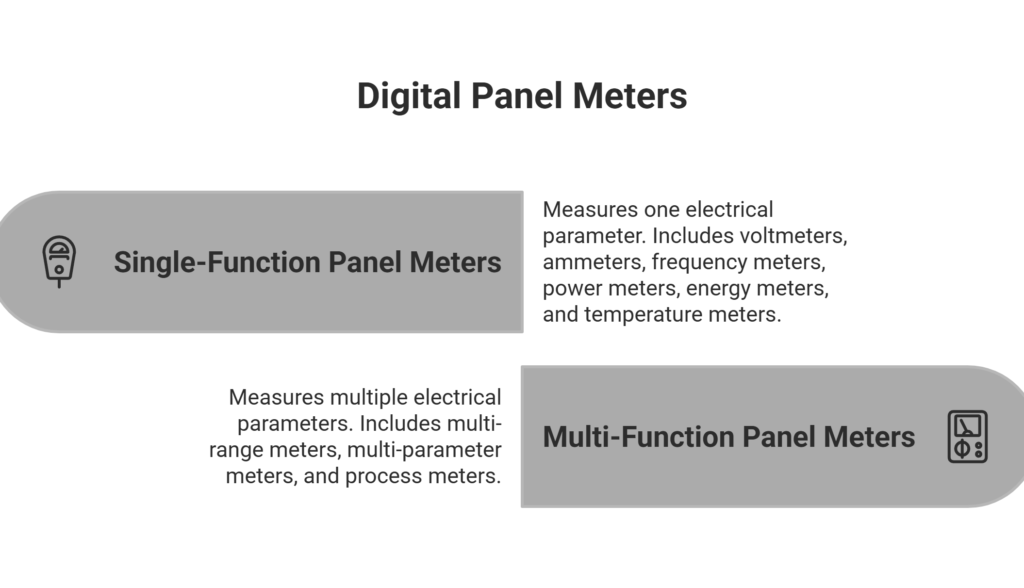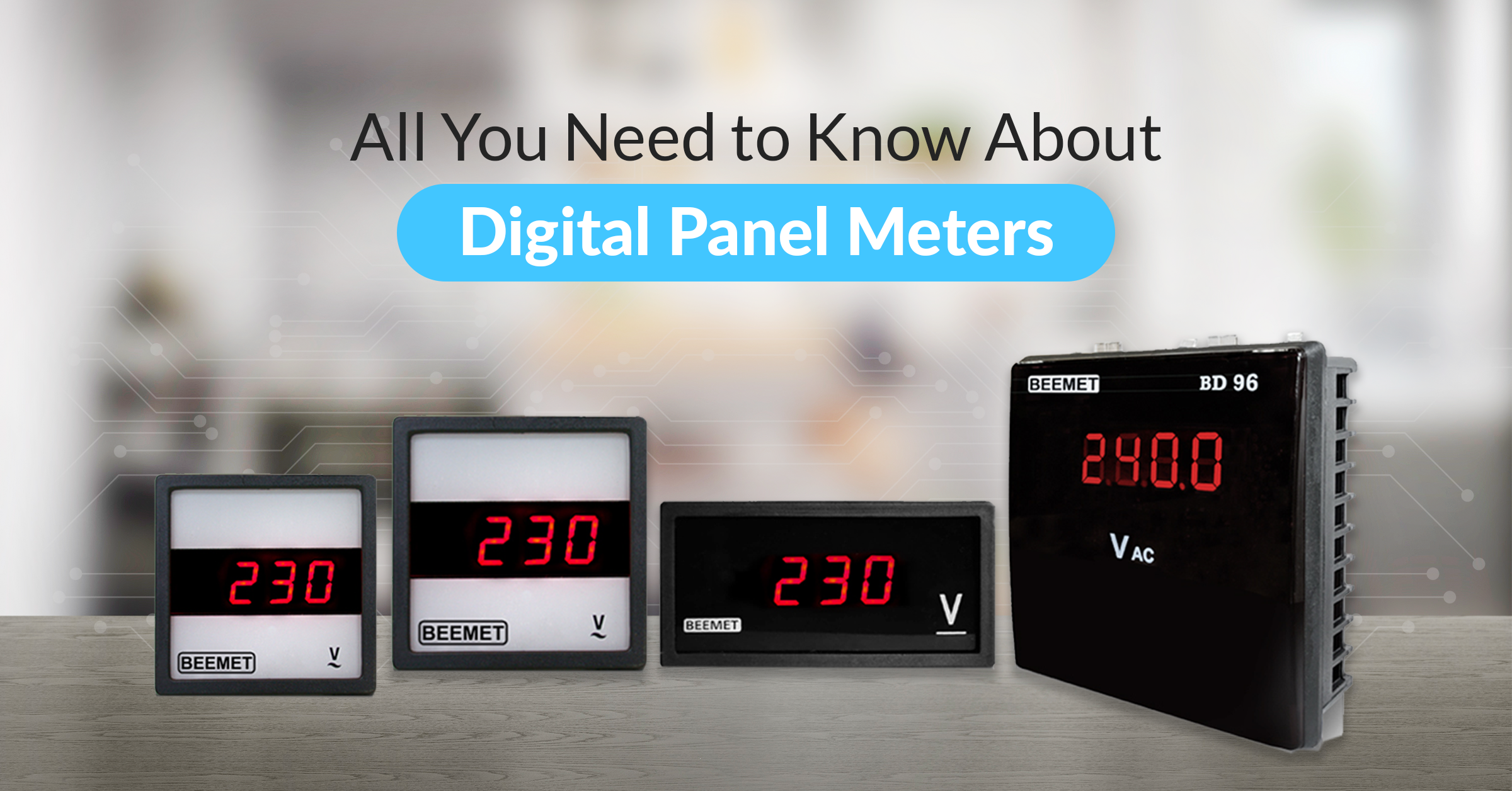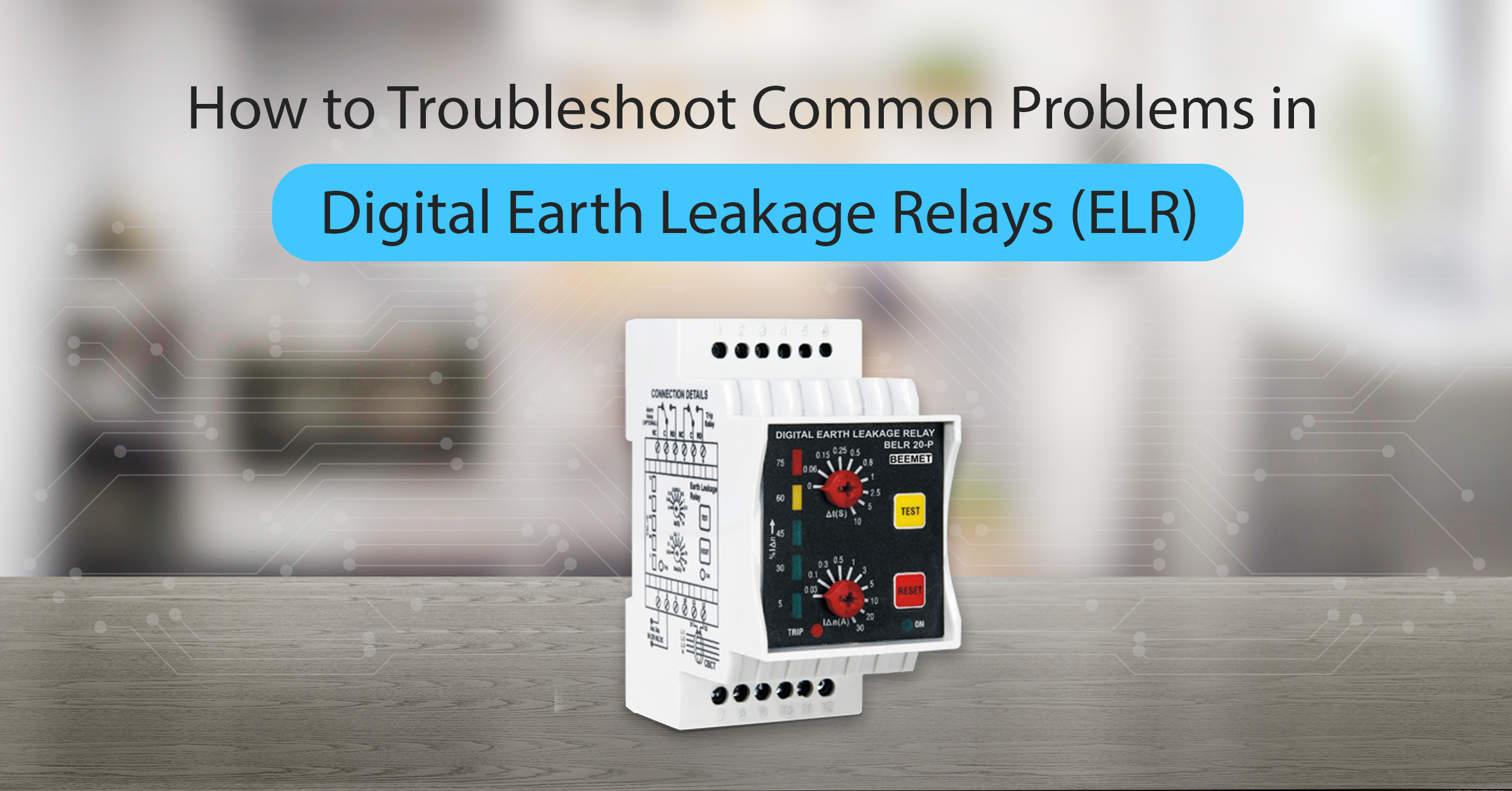What are Digital Panel Meters?
Digital panel meters are electronic devices that display electrical parameters in digital format. The digital panel shows numeric readings of a specific electrical parameter. Digital meters have higher accuracy and precision and hence find an array of electrical applications.
These industrial panel meters are widely used in both industrial and commercial applications because of their cutting-edge technology, top-notch features and ease of use.
This blog will throw light on important features of digital panel meters, their method of operation, types of digital panel meters and their applications.
TL;DR
What they are: Gadgets that show electrical readings in plain numbers. Super accurate and easy to read.
How they work: Turn electrical signals into digital numbers. No confusing dials or needles.
Types: Basic ones measure one thing. Advanced ones track multiple readings.
Where they’re used: Cars, AC units, appliances, factories — basically anywhere you need to monitor electricity.
Components of Digital Panel Meter

1. Display
The display of Digital panel meter gives numeric readings and includes indicators and symbols for alarms and units.
2. Microcontroller or Digital Signal Processor (DSP)
This is like the brain of a panel meter. It processes the measured data, performs calculations, handles user interface interactions, and controls various functions of the meter.
3. User Interface
Digital panel meters include buttons, switches, or touch-sensitive controls for user interaction. These allow users to access menu options, set configurations, navigate through different displays or modes, and configure alarms or data logging functions.
4. Power Supply
Digital panel meters require a stable power supply, typically in the form of AC (Alternating Current) or DC (Direct Current) voltage, to operate.
Method of Operation Of Digital Panel Meters
Digital Panel meters utilize Dual Slope A/D conversion for analog-to-digital signal conversion. In this method, the analog signal is integrated with a known reference voltage for a fixed period.
After nullifying any system offsets, the unknown signal is integrated for the same duration. The integrated value is then compared with a digital reference, adjusting it until a match is achieved.
This process determines the digital output code representing the input signal. Dual Slope A/D conversion ensures accurate and reliable measurement, offering benefits such as noise rejection and insensitivity to reference voltage variations.
Types of Digital Panel Meters

Mainly, there are two types of panel meters named single-function panel meters and multifunction panel meters.
Single Function Digital Panel Meters
These panel meters display only a specific parameter like current, voltage or power.
1. Voltmeters
Measure voltage levels, either AC or DC, providing readings of electrical potential difference.
2. Ammeters
Measure current flow, either AC or DC, indicating the amount of electric current passing through a circuit.
3. Frequency Meters
The frequency of an electrical signal is measured in Hertz.
4. Power Meters
Measure power consumption or power factor, helping monitor and optimize energy usage in electrical systems.
5. Energy Meters
Measure energy consumption, often in kilowatt-hours (kWh), and are used for utility billing or monitoring energy usage in homes, buildings, and industrial settings.
6. Temperature Meters
Measure temperature using thermocouples or resistance temperature detectors (RTDs), suitable for various temperature measurement applications.
Multi-Function Panel Meters
As the name suggests, these panel meters provide multiple measurements in a single device.
1. Multi-Range Meters
Provide multiple measurement ranges for voltage, current, and resistance, accommodating a wide range of values in a single meter.
2. Multi-Parameter Meters
Measure and display multiple parameters, such as voltage, current, frequency, and power, allowing comprehensive monitoring of electrical systems.
3. Process Meters
Incorporate additional features like proportional-integral-derivative (PID) control algorithms to regulate and maintain desired process parameters such as temperature, pressure, or flow rate.
Features of Digital Panel Meters
1. Large Display
Digital panel meters come with super bright LED displays that are large and easy to read. This is for long-distance day light viewing.
2. Accuracy
This refers to how closely the meter measures the actual value. Digital panel meters are known for their high accuracy, providing precise measurements to ensure reliable data for critical operations and applications
3. User-Friendly Interface
These meters feature user-friendly interfaces with intuitive controls and menus, making it easy to set up and navigate through different functions and settings.
4. Energy Efficiency Features
Look for digital panel meters equipped with energy-efficient features. Such meters will help you minimize power consumption and reduce operational costs.
5. Easy to Maintain
Digital panel meters are easy to maintain as they have a solid-state design and minimal moving parts.
6. Customizable
Yes, you read it right! Digital panel meters can be customized, allowing users to configure display format, units, and scaling as per their requirements.
7. Alarm Functions
Some meters include alarm features that allow you to set threshold levels for the measured parameter. If the parameter exceeds or falls below the set limits, the meter triggers an alarm, alerting the user to take appropriate actions.
8. Software Compatibility
Check if the meter is compatible with software applications that enable data logging, analysis, and visualization, providing enhanced functionality and data management options.
Applications of Digital Panel Meters
Digital meters find various applications because of their high precision and accuracy.
1. HVAC Systems
In HVAC systems, digital panel meters are used to measure variables like temperature, airflow and pressure, thereby providing accurate information to the operators.
2. Automobile Industry
Similarly, digital panel meters are used in vehicles to display critical information such as speed, fuel level, and engine temperature, providing drivers with real-time data for safe and efficient operation.
3. Electrical Safety
Digital panel meters help in monitoring voltage levels, current flow, and power consumption, ensuring safe operation and preventing electrical hazards.
4. Energy Monitoring
Digital panel meters are used to track electricity usage in homes and businesses, helping users manage their energy consumption and make informed decisions to reduce costs.
5. Security Systems
Digital panel meters find applications in security systems to monitor and display information related to access control, surveillance, and alarm systems, ensuring premises security and monitoring.
6. Home Appliances
Digital panel meters are integrated into appliances like ovens, refrigerators, and washing machines, displaying settings, time remaining, and energy consumption, allowing users to monitor and control their usage.
Digital Panel Meter Working Principle
At its core, the working principle of digital panel meters is all about converting analog signals into readable numbers. These meters convert analog electrical signals from various sources such as sensors and instruments into digital numerical values that are displayed with precision.
The continuous signal is transformed into discrete digital values through a process known as analog-to-digital conversion. These digital values are then displayed on the meter, making measurements easily understandable. The displayed numerical values are a direct representation of the measured quantity, ensuring accuracy and reducing the potential for human error in reading analog instruments.
Digital panel meters can measure a range of parameters such as voltage, current, frequency, temperature, and more which makes them suitable for a wide range of applications.
They provide an easy-to-read interface with clear numerical displays. The straightforward design eliminates confusion, making measurements swift and hassle-free, even for those without an in-depth technical background.
Maintenance of Digital Panel Meter
Maintaining digital panel meters ensures optimal performance. Here’s a simple guide to help you keep your digital panel meters in top shape:
Regular Inspection: Inspect digital panel meters regularly for any signs of wear, damage, or malfunction.
Connection Check: Ensure all connections are secure. Loose connections can lead to erratic readings or even failure.
Temperature: Ensure they operate within their specified temperature range for reliable performance.
Power Supply Check: Ensure the power supply to your meters is stable. Fluctuations can impact their accuracy.
Manufacturer’s Guidelines: Adhere to the manufacturer’s maintenance recommendations. They’re tailored for your specific meter model.
At BEEMET, we understand the importance of precise measurements. Our digital panel meters are designed to be user-friendly and reliable, and proper maintenance ensures they deliver consistent performance
Bottom Line
Digital Panel meters are crucial for measuring and monitoring electrical parameters. They offer high accuracy and precision, making them a convenient and versatile option. Explore a range of digital panel meters by BEEMET.
Recommended read – All you need to know about Analog Panel meters.
FAQs
The choice between analog and digital panel meters depends on the specific needs of the application. Analog meters are simpler and offer continuous indication, while digital meters provide higher accuracy, direct numerical readings, and advanced features.
Analog panel meters use moving pointers on a scale, while digital panel meters display numeric values directly, offering higher accuracy and additional functionalities.
Indeed, a digital panel meter generally offers increased reliability compared to an analog panel meter. The digital panel meter’s enhanced accuracy, readability, and additional features often make it the preferred choice for applications that demand high reliability and precision.



